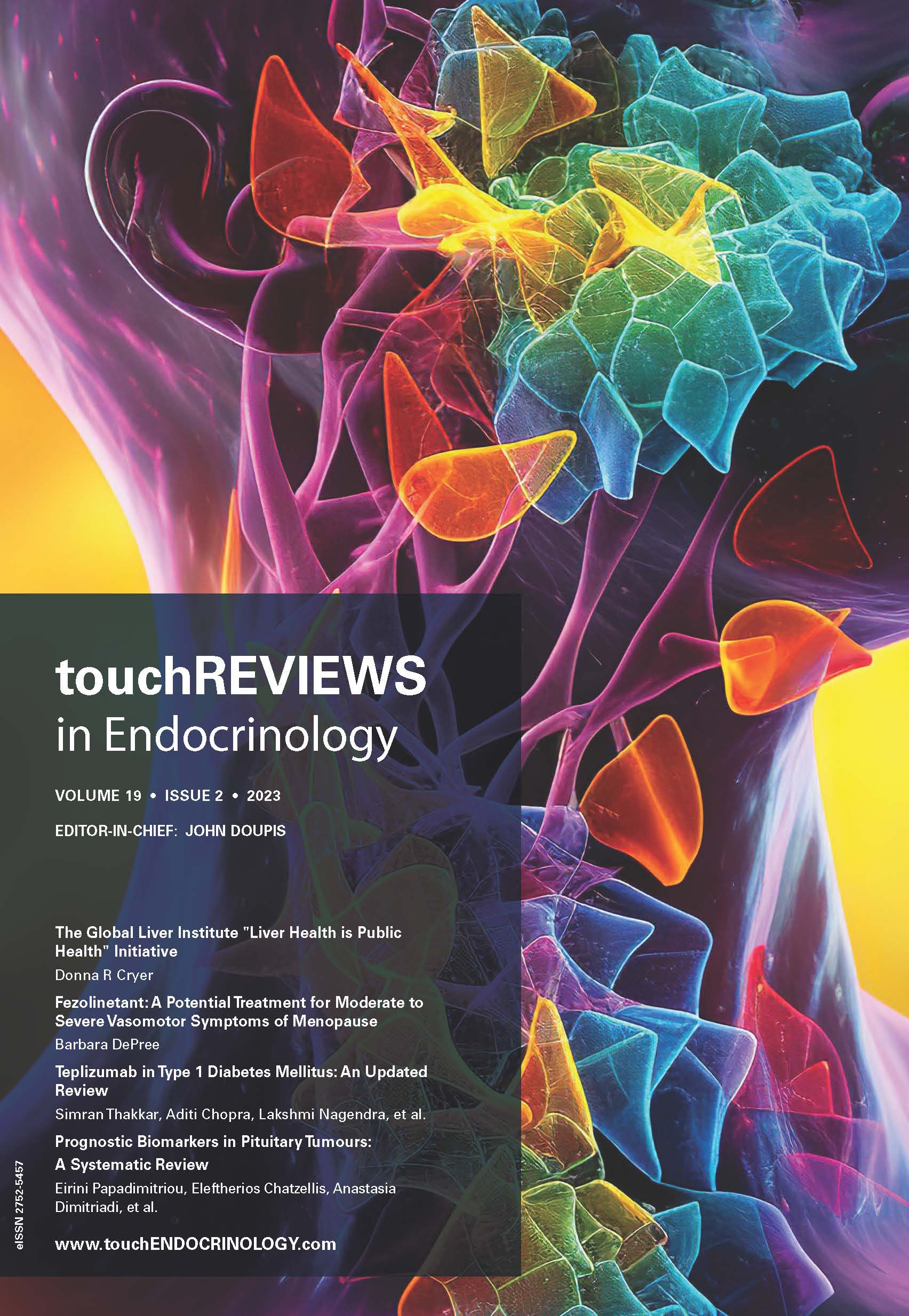European Endocrinology – Volume 15 Issue 1 – Spring 2019
Welcome to the Spring edition of European Endocrinology, which features a diverse range of articles covering osteoporosis, pituitary gland, diabetes, obesity, thyroid and some more specialist areas in endocrine oncology and sarcopenia.
The global crisis of diabetes features prominently in this issue, in particular the challenges of living with diabetes. Lifestyle interventions can improve glycaemic control, but adherence is often poor. This edition features two original research studies in the field of diabetes from Tsai et al. and editorial board member Sanjay Kaira.
We present two case reports, with the aim of raising awareness of rare diseases of the thyroid gland, and a fascinating review article discussing novel therapies for pituitary adenomas – the second most common intracranial tumour.
European Endocrinology would like to thank all authors who contributed towards this edition. We hope that the expert content provides useful information and discussions that are relevant to your practice and interests.
Happy reading!
Foreword
Welcome to the Spring edition of European Endocrinology, which features a diverse range of articles covering a number of therapeutic areas. The increase in life expectancy in the 21st century has brought challenges in maintaining the musculoskeletal health of an ageing population. In our opening editorial by Laskou and Dennison discusses the impact of physical activity and […]
Editorial
As the population ages, the need to promote good musculoskeletal health throughout the lifecourse increases. Physical activity and adequate nutrition are known to be beneficial to bone and muscle at all ages; individually the benefits of physical activity and inadequate or excessive nutrition on bone and muscle have been extensively researched. It is well recognised […]
Definition and Classification Sarcopenia, an age-related loss of muscle mass and power, was recently recognised as a disease and received an International Classification of Diseases (ICD)-10 code M62.84 (September 2016).1 The European Working Group on Sarcopenia in Older People (EWGSOP) defined it as a syndrome characterised by a progressive loss of skeletal muscle mass and […]
The family and diabetes’ is the International Diabetes Federation (IDF) theme for 2018 and 2019.1 A similar theme was chosen for the Ahmedabad Declaration, released at the annual conference of the Research Society for Study of Diabetes in India (RSSDI). The family has been described as a cause and culprit of diabetes, as well as […]
Review
Type 2 diabetes mellitus (T2DM) is a chronic disease characterised by hyperglycaemia and compounded by insufficient production of insulin (beta cell dysfunction) to overcome the ineffective action of insulin (insulin resistance). According to International Diabetes Federation Eighth Atlas (2017), there were 425 million diabetic people (20–79 years of age) worldwide.1 The number of people affected […]
The overall association between obesity and type 2 diabetes is so linear and strong that a causal relationship between the two has traditionally been assumed.1 There are some questions, however, yet to be answered.2 The association of diabetic complications with obesity has consistently shown paradoxical results.3,4 In people with diabetes with a higher body mass […]
Pituitary adenomas are benign tumours that arise from the adenohypophysis. They are the second most frequent intracranial tumour type after meningiomas, and account for 16.2% of all primary cranial neoplasms.1 Though likely an underestimate, the incidence of pituitary adenomas is approximately four per 100,000 persons per year,2,3 and incidence increases with age.4 Prolactinomas and non-functioning […]
Case Report
Thyroid abscess is rare, accounting for less than 0.7% of surgical pathologies involving the thyroid gland.1,2 This is attributed to its rich blood supply and lymphatic drainage, high concentration of iodine that inhibits bacterial growth, protective fibrous capsule, and fascial planes separating it from other neck structures.2–4 Patients with a thyroid abscess usually associate their […]
Malignancies of the thyroid are one of the most common neoplasms and predominantly affect females. Differentiated thyroid carcinomas include papillary and follicular carcinomas (accounting for 90–95% of all cases).1 Papillary carcinoma is the most common type of all thyroid malignancies, while medullary thyroid carcinoma comprises 6% of all cases.1 Rarer types include anaplastic carcinomas, lymphomas […]
Original Research
The purpose of this study was to develop a measure of type 1 diabetes mellitus (T1DM) knowledge that is aimed at youth and is based on contemporary management standards. The Mercy What I Know About Diabetes (M-WIKAD) is a 19-item questionnaire that is a valid measure of diabetes knowledge in youth with T1DM. Factor […]
Diabetes distress is a common occurrence in people diagnosed with diabetes.1 It is defined as an emotional response characterised by extreme apprehension, discomfort or dejection, due to perceived inability in coping with the challenges and demands of living with diabetes.2 Women with gestational diabetes have been reported to use various coping strategies to address the […]

Trending Topic
Approximately 20–34% of hospitalized patients have a diagnosis of diabetes, while many others experience stress hyperglycaemia, both increasing the occurrence of dysglycaemia in the hospital.1 Hyperglycaemia is associated with increased infection rates and higher mortality rates. Conversely, hypoglycaemia can lead to adverse neurological outcomes, prolonged hospital stays, as well as increased mortality.1 In spite of current guidelines […]
Journal Archive
touchREVIEWS in Endocrinology (previously European Endocrinology) is a peer-reviewed, free-to-access, bi-annual journal comprising review articles, case reports, editorials, special reports and original research. It features balanced and comprehensive articles written by leading authorities, addressing the most important and salient developments in the field of endocrinology.
Latest articles videos and clinical updates - straight to your inbox
Log into your Touch Account
Earn and track your CME credits on the go, save articles for later, and follow the latest congress coverage.
Register now for FREE Access
Register for free to hear about the latest expert-led education, peer-reviewed articles, conference highlights, and innovative CME activities.
Sign up with an Email
Or use a Social Account.
This Functionality is for
Members Only
Explore the latest in medical education and stay current in your field. Create a free account to track your learning.
















